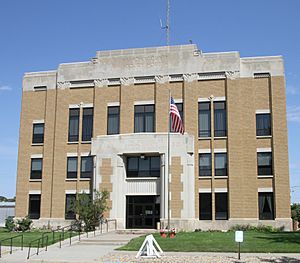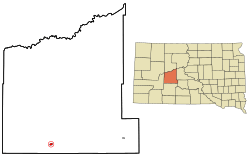Philip, South Dakota facts for kids
Quick facts for kids
Philip, South Dakota
|
|
|---|---|

Haakon County Courthouse in Philip, August 2017
|
|
| Motto(s):
"Where The Sun Kisses The Earth"
|
|

Location in Haakon County and the state of South Dakota
|
|
| Country | United States |
| State | South Dakota |
| County | Haakon |
| Founded | 1907 |
| Area | |
| • Total | 0.59 sq mi (1.54 km2) |
| • Land | 0.59 sq mi (1.54 km2) |
| • Water | 0.00 sq mi (0.00 km2) |
| Elevation | 2,195 ft (669 m) |
| Population
(2020)
|
|
| • Total | 759 |
| • Density | 1,277.78/sq mi (493.18/km2) |
| Time zone | UTC−7 (Mountain (MST)) |
| • Summer (DST) | UTC−6 (MDT) |
| ZIP code |
57567
|
| Area code(s) | 605 |
| FIPS code | 46-49300 |
| GNIS feature ID | 1267530 |
Philip is a city in and the county seat of rural Haakon County, South Dakota, United States. The population was 759 at the 2020 census.
History
Philip was laid out in 1907 when the Chicago and North Western Railway was extended to that point. It was incorporated in 1908. In 1914, Philip was designated seat of the newly formed Haakon County. The city was named for James "Scotty" Philip; the local high school mascot is the Scotch terrier, or "Scottie", in his honor.
Economy
Agriculture is the primary industry in Philip. Businesses include two grain elevators, a livestock auction, veterinary clinic, and numerous other businesses providing goods and services related to the farms and ranches surrounding the community.
Philip is also home to Scotchman Industries, a manufacturer of metal fabrication machinery (hydraulic ironworkers, circular cold saws, band saws, tube & pipe notchers & measuring systems). The hospital and school are other major sources of employment within the community.
Geography
According to the United States Census Bureau, the city has a total area of 0.60 square miles (1.55 km2), all land.
Philip is located on the banks of the Bad River, which empties into the Missouri River at Fort Pierre.
Climate
Philip has a cool semi-arid climate (Köppen BSk). Winters are generally freezing, although warm chinook winds bring temperatures above 50 °F or 10 °C on sixteen afternoons during an average December to February period. Aridity during this period limits snowfall to a mean of 27.0 inches or 0.69 metres and a median of 18.2 inches (0.46 m), with median snow depth never above 2 inches (0.051 m). Overall Philip has a USDA hardiness zone of 4b, with minimum temperatures ranging from −25 to −20 °F (−31.7 to −28.9 °C).
During spring temperatures warm steadily, although 2.7 mornings in May still expect subfreezing minima. Thunderstorm rains make this the wettest time of the year, with averages around 3 inches or 76 millimetres of rain falling in May and June. During settled dry spells in the summer, temperatures can become exceedingly hot: the record being 116 °F or 46.7 °C on July 15, 2006, while sustained spells of sweltering and extremely dry weather are not uncommon, for instance July 1974 averaged a maximum of 96.6 °F (35.9 °C) and July 2012 98.2 °F (36.8 °C). The whole calendar year of 2012 saw only 7.15 inches (181.6 mm) of precipitation, whereas the single month of May 1982 saw as much as 8.83 inches (224.3 mm).
| Climate data for Philip Airport (2,206 feet or 672 metres above sea level) 1991–2020 normals, extremes 1907–present | |||||||||||||
|---|---|---|---|---|---|---|---|---|---|---|---|---|---|
| Month | Jan | Feb | Mar | Apr | May | Jun | Jul | Aug | Sep | Oct | Nov | Dec | Year |
| Record high °F (°C) | 75 (24) |
76 (24) |
88 (31) |
96 (36) |
105 (41) |
112 (44) |
116 (47) |
113 (45) |
108 (42) |
97 (36) |
84 (29) |
72 (22) |
116 (47) |
| Mean maximum °F (°C) | 59.0 (15.0) |
62.9 (17.2) |
74.8 (23.8) |
84.8 (29.3) |
90.7 (32.6) |
99.8 (37.7) |
104.0 (40.0) |
103.6 (39.8) |
99.3 (37.4) |
86.7 (30.4) |
72.8 (22.7) |
59.0 (15.0) |
106.0 (41.1) |
| Mean daily maximum °F (°C) | 34.1 (1.2) |
37.8 (3.2) |
48.9 (9.4) |
59.2 (15.1) |
70.0 (21.1) |
81.0 (27.2) |
89.5 (31.9) |
88.5 (31.4) |
79.0 (26.1) |
62.9 (17.2) |
48.1 (8.9) |
36.3 (2.4) |
61.3 (16.3) |
| Daily mean °F (°C) | 22.1 (−5.5) |
25.2 (−3.8) |
35.5 (1.9) |
45.6 (7.6) |
56.6 (13.7) |
67.4 (19.7) |
75.0 (23.9) |
73.2 (22.9) |
63.3 (17.4) |
48.3 (9.1) |
34.9 (1.6) |
24.2 (−4.3) |
47.6 (8.7) |
| Mean daily minimum °F (°C) | 10.2 (−12.1) |
12.6 (−10.8) |
22.1 (−5.5) |
32.0 (0.0) |
43.3 (6.3) |
53.7 (12.1) |
60.4 (15.8) |
58.0 (14.4) |
47.6 (8.7) |
33.8 (1.0) |
21.6 (−5.8) |
12.2 (−11.0) |
34.0 (1.1) |
| Mean minimum °F (°C) | −14.9 (−26.1) |
−10.3 (−23.5) |
−0.7 (−18.2) |
14.5 (−9.7) |
27.3 (−2.6) |
40.8 (4.9) |
49.1 (9.5) |
45.8 (7.7) |
33.2 (0.7) |
17.2 (−8.2) |
2.0 (−16.7) |
−12.1 (−24.5) |
−21.6 (−29.8) |
| Record low °F (°C) | −35 (−37) |
−33 (−36) |
−29 (−34) |
2 (−17) |
15 (−9) |
32 (0) |
37 (3) |
36 (2) |
20 (−7) |
−7 (−22) |
−25 (−32) |
−30 (−34) |
−35 (−37) |
| Average precipitation inches (mm) | 0.43 (11) |
0.47 (12) |
0.89 (23) |
1.71 (43) |
2.96 (75) |
2.90 (74) |
1.83 (46) |
1.48 (38) |
1.23 (31) |
1.45 (37) |
0.49 (12) |
0.44 (11) |
16.28 (414) |
| Average precipitation days (≥ 0.01 in) | 5.3 | 5.1 | 6.2 | 8.9 | 10.6 | 11.4 | 8.3 | 7.5 | 6.1 | 6.3 | 3.9 | 5.0 | 84.6 |
| Source: NOAA | |||||||||||||
Demographics
| Historical population | |||
|---|---|---|---|
| Census | Pop. | %± | |
| 1910 | 578 | — | |
| 1920 | 647 | 11.9% | |
| 1930 | 786 | 21.5% | |
| 1940 | 833 | 6.0% | |
| 1950 | 810 | −2.8% | |
| 1960 | 1,114 | 37.5% | |
| 1970 | 983 | −11.8% | |
| 1980 | 1,088 | 10.7% | |
| 1990 | 1,077 | −1.0% | |
| 2000 | 885 | −17.8% | |
| 2010 | 779 | −12.0% | |
| 2020 | 759 | −2.6% | |
| U.S. Decennial Census | |||
2010 census
As of the census of 2010, there were 779 people, 375 households, and 197 families residing in the city. The population density was 1,298.3 inhabitants per square mile (501.3/km2). There were 423 housing units at an average density of 705.0 per square mile (272.2/km2). The racial makeup of the city was 94.4% White, 0.3% African American, 2.2% Native American, 0.8% Asian, and 2.4% from two or more races. Hispanic or Latino of any race were 1.2% of the population.
There were 375 households, of which 20.0% had children under the age of 18 living with them, 44.3% were married couples living together, 6.9% had a female householder with no husband present, 1.3% had a male householder with no wife present, and 47.5% were non-families. 44.8% of all households were made up of individuals, and 24% had someone living alone who was 65 years of age or older. The average household size was 1.98 and the average family size was 2.79.
The median age in the city was 51.5 years. 19.1% of residents were under the age of 18; 4.4% were between the ages of 18 and 24; 18.7% were from 25 to 44; 30.3% were from 45 to 64; and 27.5% were 65 years of age or older. The gender makeup of the city was 45.8% male and 54.2% female.
Notable people
- Patrick Henry Brady – Medal of Honor recipient for service in the Vietnam War
- Lincoln McIlravy – bronze medalist in wrestling at the 2000 Summer Olympics
See also
 In Spanish: Philip (Dakota del Sur) para niños
In Spanish: Philip (Dakota del Sur) para niños

